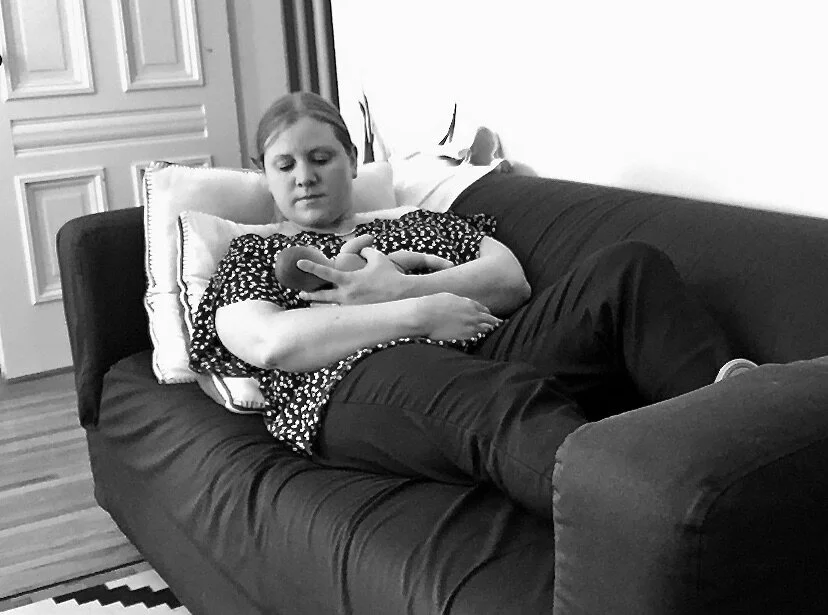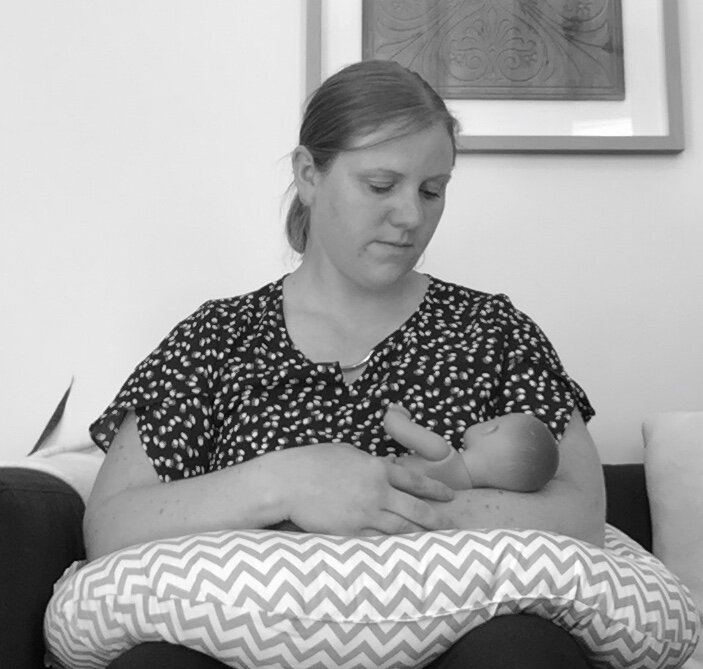Tips for Minimizing Feeding-Related Pain After A Cesarean Birth
So, Cesarean birth was the way you got to meet your precious baby! It may or may not have been the journey you expected. The pain afterwards may also not have been what you expected. Regardless, here you are, things hurt like hell and you’ve got to feed your baby. Below are a few suggestions that I hope will make things more comfortable for you as you nourish your little one after having undergone a Cesarean birth. These tips apply to women who are breast-feeding OR bottle-feeding.
1) Have baby brought to you.
As much as possible, have someone bring baby to you when it’s time for them to be nourished! This could be a partner, family member, neighbour, friend or postpartum doula. Early on in your recovery, limit how often you are up & down, in & out of bed as well as lifting & lowering baby from the bassinet/crib. Trust me, your body will thank you in those first few days after surgery!
2) Stay on top of your pain medication. Keep your pain levels in check.
If breast-feeding or pumping, many women are nervous about taking pain medication for fear that it will get passed on to baby through the breast milk. Please note that most pain medications are safe to take while breastfeeding. Conservatively stated, less than 1% of NSAIDS transfer to baby (when taken orally…as most of you will be doing). This remains well below any dosage that would be prescribed for your child.1
“Orally administered NSAIDs are excreted into breast milk in low concentrations. Ibuprofen has a short half-life with a relative infant dose that ranges from 0.6% in colostrum to less than 0.38% in mature milk, equivalent to approximately 0.2% of the pediatric dose. Given the very low concentrations in breast milk, ibuprofen use is acceptable and the likely preferred first-line agent for postpartum pain.”
Initially, many women require more help for pain relieve. Opiods (such as codeine or tramadol) may be used in the first couple of days in combination with other medications. Opiods can be a useful tool for treating what we call “breakthrough pain”, severe pain that shows up even when on other pain medications. However, in order to implement them in the safest way we know, it is recommended that you be on this form of medication for a short amount of time only (no longer than 4 days) and that baby is monitored for signs of sedation. Infant sedation may show up as being difficult to wake for feedings, as having difficulty feeding or showing signs of limpness. Keep in mind that this happens in only ~2% of infants.3
Something else to consider, however, is that staying on top of medications can also impact breastfeeding in a more helpful way. Did you know that pain can inhibit the release of oxytocin, a hormone important for encouraging milk flow?2 So, staying on top of pain medication can have a positive impact on milk flow.2
If you are still adamant that you don’t want to take pain meds, at the very least, make sure you don’t overdo things! Yes, I’m looking at you “productive”, driven and antsy momma! Gentle movement and short walks within your pain tolerance can be helpful in mitigating pain, releasing endorphins (one of your body’s natural, internal pain fighters) and increasing circulation to help with healing.2 However, if you over-do things pain will most likely increase. You should never be more sore than ~3-4/10 pain for longer than 30-45 minutes after completing approved forms of exercise.
I am by no means a medication master. Please speak to your doctor or pharmacist for more thorough and individualized advice or if you have questions/concerns about pain control postpartum.
3) Try different feeding positions
Whether you are bottle-feeding or breast-feeding your precious babe, the following positions can be helpful to limit aggravation of the healing tissue. If you have an active baby, these positions will also limit the probability of getting kicked in the guts and that awful feeling that your incision is going to burst open at any moment (been there, felt that!). Keep in mind that some of these positions might not feel great to you - that’s ok! Stick only with the ones that are helpful!
a) Sitting upright with a nursing pillow: The pillow helps brace the incision site and protects from squirming feet and legs. If you have a long torso, you may require a second pillow to elevate baby up to the breast - resist the temptation to slouch and bring the breast down to baby! Slouching down can put uncomfortable pressure at the incision site.
b) Sitting upright - Football hold: This positions baby off to the side of your body. Their head is cradled in your hand and their body is elevated with pillows to a comfortable height at the breast. Again, don’t slouch!
c) Side-lying: Once it feels comfortable to lay on your side, you can nurse with baby accessing either the bottom or the top breast.
Laid-back: Hold baby in a cradle or cross-cradle position up away from the incision site. Use a pillow over the incision for further protection. For babies with an established latch, you can also try placing the baby vertical along your torso (instead of across it) - for this position you’ll want to watch feet and knee kicks to the lower abs (pillow!). Letting baby nurse in this laid-back position may allow both of you to make use of many different nursing reflexes. It also takes the work and discomfort out of holding yourself in an upright position for hours of the day. While in hospital, simply elevate the head of the bed. At home, use pillows to prop yourself up. This article from La Leche has a great summary if you wish to know more about the benefits of this particular position: https://lllusa.org/lie-back-and-relax-a-look-at-laid-back-breastfeeding/.
4) Be patient with yourself
If you are breastfeeding, keep in mind that having a Cesarean birth may make it more difficult to establish breastfeeding, impact milk supply and throw off an infant’s receptivity to breastfeeding.4
If breastfeeding is your goal, know that it’s not something you’re doing wrong. Give yourself a little bit more time knowing that the biological processes that get naturally set off through vaginal birth may not have been stimulated in the same way with a Cesarean birth. Stick with it and get professional assistance from a Registered Lactation Consultant or Breastfeeding Counsellor if you are struggling.
Some simple things you can try to limit these potential impacts are to breastfeed as soon as possible after your Cesarean (ideally within the first hour) and have lots of skin-to-skin contact with your baby. Assuming your infant doesn’t require immediate medical attention, many surgeons are allowing this to happen right in the operating room. If you haven’t yet had your Cesarean and are reading this as a way to prepare, be sure to let your healthcare provider know if this is something you’d like to have happen.
Hope you find these tips helpful in your recovery! For more information or to book a spot in our Cesarean Birth Recovery Workshop check out rebirthwellness.ca.
References
Sachs, H. C., & DRUGS, C. O. (2013). The Transfer of Drugs and Therapeutics Into Human Breast Milk: An Update on Selected Topics. Paediatrics. do: 10.1542/peds.2013-1985, [https://pediatrics.aappublications.org/content/108/3/776]. Accessed online July 24, 2019.
“Breastfeeding After Cesarean Delivery.” HealthyChildren.Org, [https://www.healthychildren.org/English/ages-stages/baby/breastfeeding/Pages/Breastfeeding-After-Cesarean-Delivery.aspx.] Accessed online July 24, 2019.
Postpartum pain management. ACOG Committee Opinion. No. 742. American College of Obstetricians and Gynecologists. Obstet Gynecol 2018; 132. DOI: 10.1097/AOG.0000000000002683. Epub 2018 May 18. [ https://www.acog.org/Clinical-Guidance-and-Publications/Committee-Opinions/Committee-on-Obstetric-Practice/Postpartum-Pain-Management?IsMobileSet=false]. Accessed online July 24, 2019.
Hobbs, AJ, Mannion, CA, McDonald SW, Brockway, M, Tough, SC. (2016). The impact of cesarean section on breastfeeding initiation, duration, and difficulties in the first four months postpartum. BMC Pregnancy Childbirth. 16: 90.




